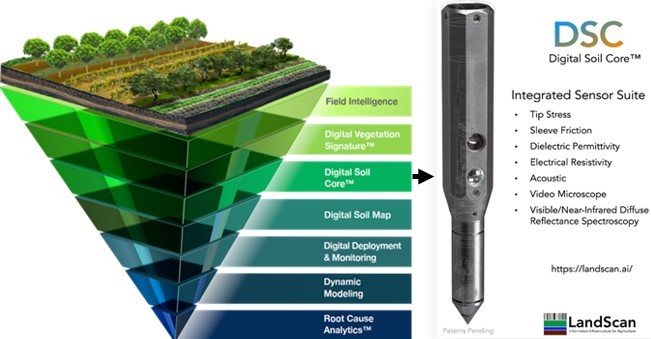
The Digital Soil Core (DSC) has changed the way soil is characterized by providing rapid, digital, objective, repeatable, and transferable metrics of the complete soil profile in about 1 minute.

The real power of the DSC comes from the synergies derived from having 7 independent sensors. Each sensor modality is orthogonal to the others, maximizing the information content available to characterize every centimeter of the soil profile.
Orthogonal sensor modalities are simply multiple ways of sensing the same phenomenon using different mechanisms. Think of your experience of a campfire. You see the flames by detecting the photons they emit, you feel the fire’s intensity by the long wave radiation reaching your skin, you hear its combustion by the sizzle and crackle reaching your ears, and you probably smell the smoke being generated. Each sense is an indirect measure of the fire in its own way, together they give you absolute confidence in the presence and intensity of the campfire. The orthogonality of sensor modalities is critical to correctly selecting between competing hypotheses. Imagine again feeling the heat of a campfire, but hearing the whir of an electric motor, smelling nothing, and seeing a blow dryer.
An extremely important consideration in our development of the DSC was consideration of the interplay of orthogonality and degrees of freedom. Degrees of freedom of an estimate is the number of independent pieces of information that went into calculating the estimate. When we account for the dimensionality of information within single sensors like video, audio, or spectrometry, the DSC provides over 1200 independent pieces of information for every centimeter of soil it encounters, enabling accurate quantification of numerous soil properties.

When, in contrast, you read claims that a handful of sensor channels, all exploiting the same sensing modality, can accurately quantify dozens of independent parameters, be very skeptical. Unless the output variables are very highly correlated, there are not enough degrees of freedom among the estimators to support the output. It is an ill-conditioned problem. If the output variables are highly correlated, then what value are they?

Some purveyors of single- or two-mode mapping solutions will claim that the magic of machine learning enables the creation of all this rich property information from a handful of inputs. Worth considering is that even sophisticated machine learning algorithms – in fact, especially sophisticated ML algorithms – are merely a collection of statistical models arranged hierarchically in a manner that exploits the mathematical principle of composability to tease out sometimes very complicated (and hopefully causal) relationships between variables. As such, they are still beholden to fundamental principles governing the limits of statistical inference. DSC, with its multiple orthogonal sensors and high data dimensionality, stands unrivaled for soil information content.

All sensors are indirect. Nothing literally measures the size of every soil particle or counts the carbon atoms in every gram, but DSC gets closer to the soil than anything else. And together, the orthogonality and dimensionality of the DSC’s sensor data enable highly quantitative results.
Learn more: https://landscan.ai/platform/digital-soil-core/